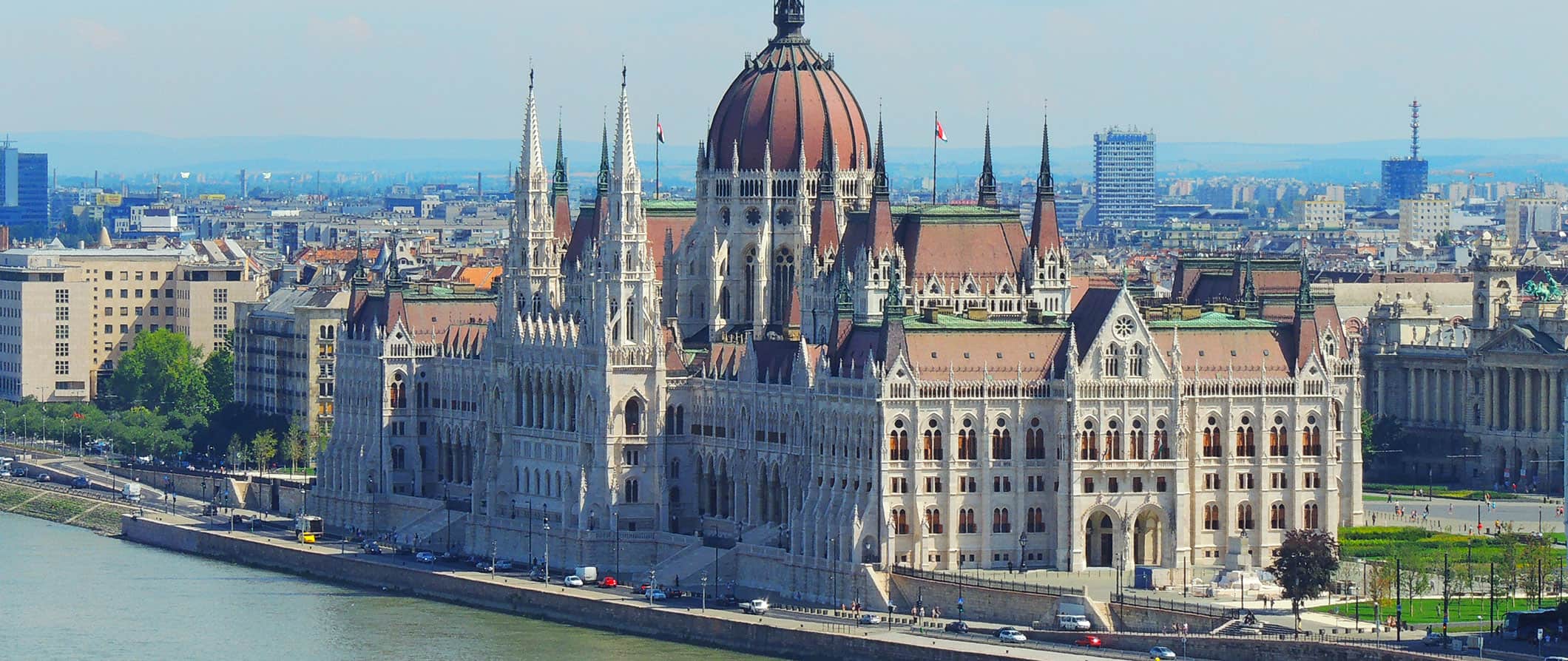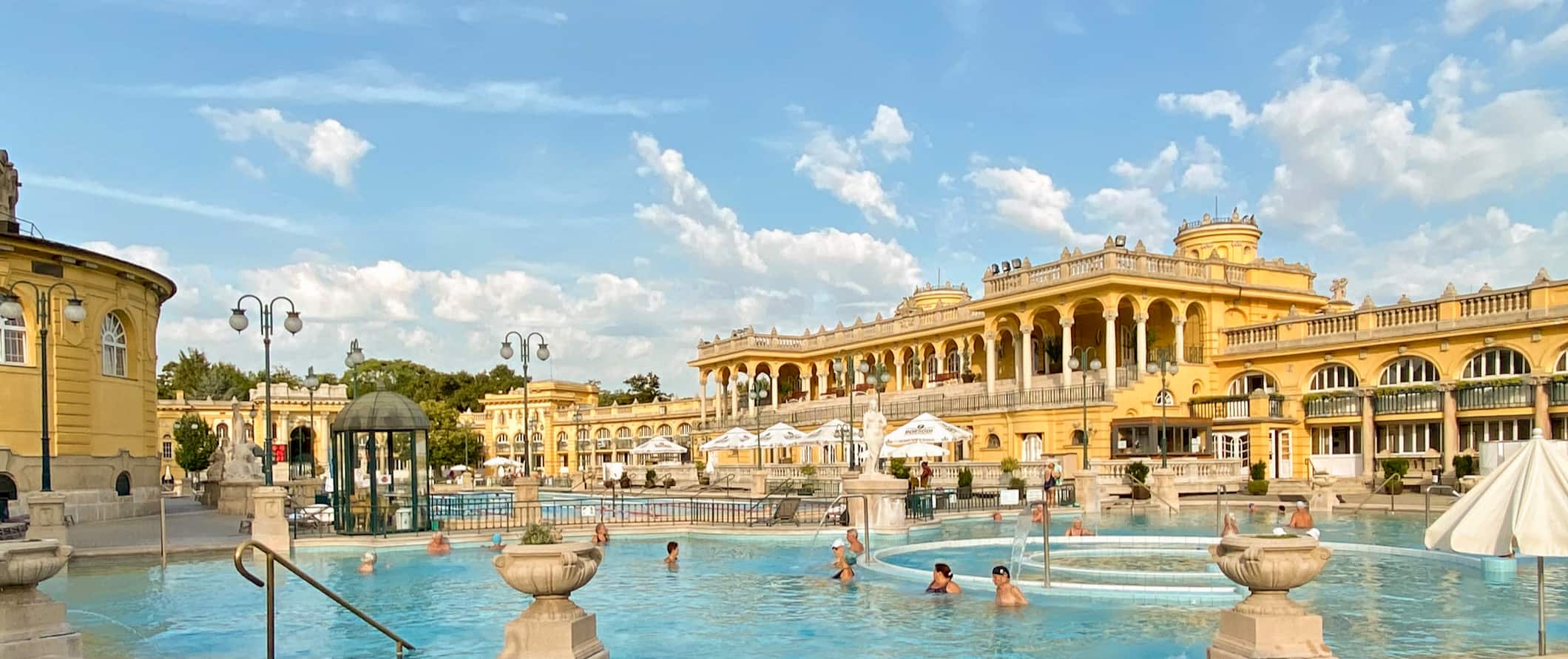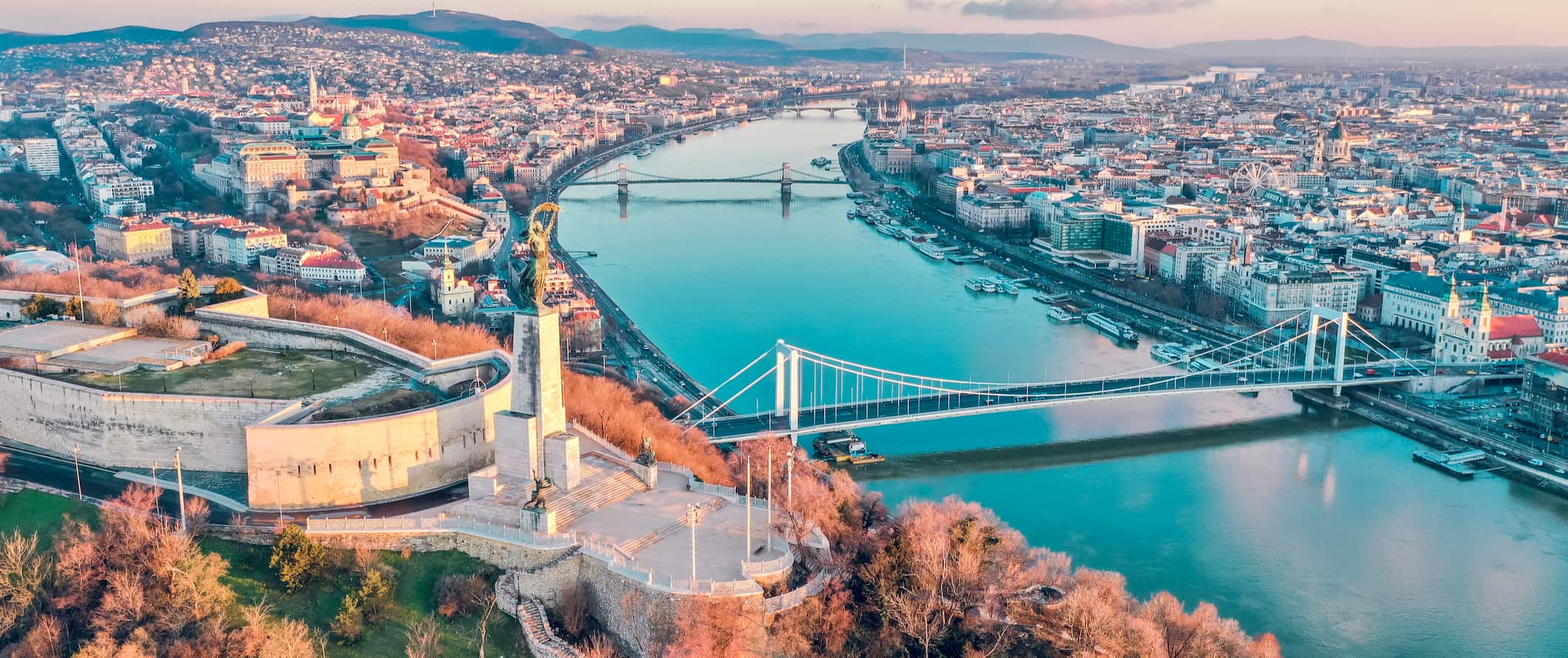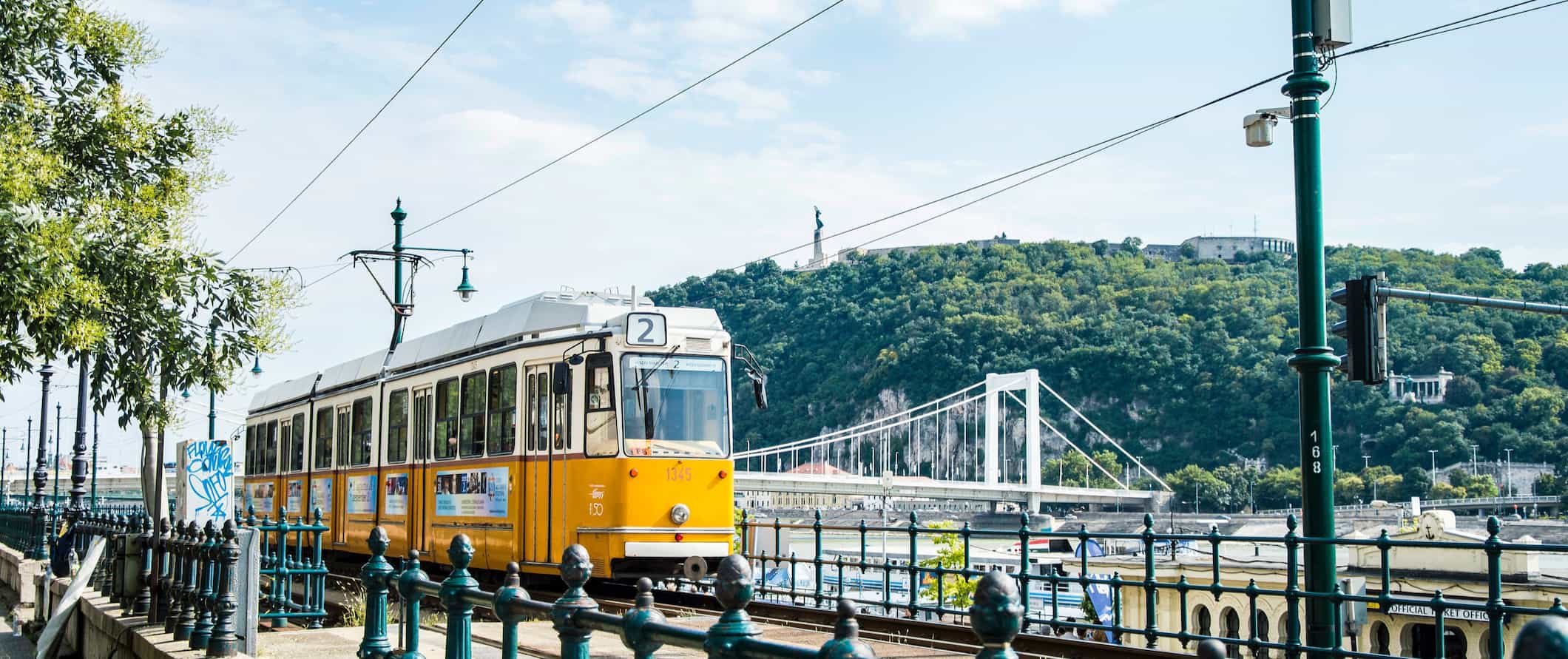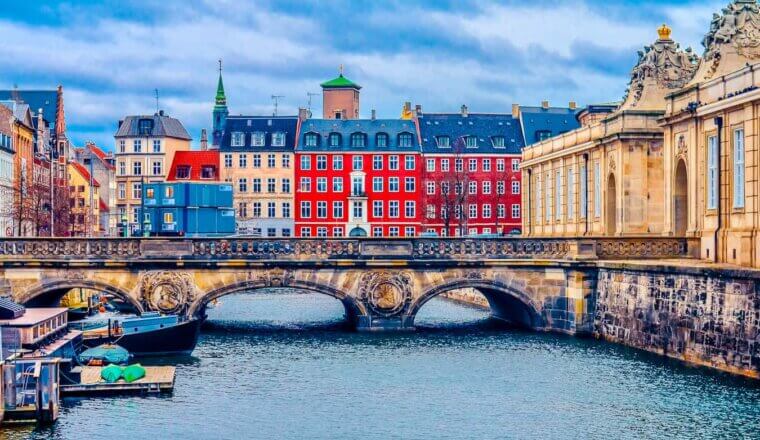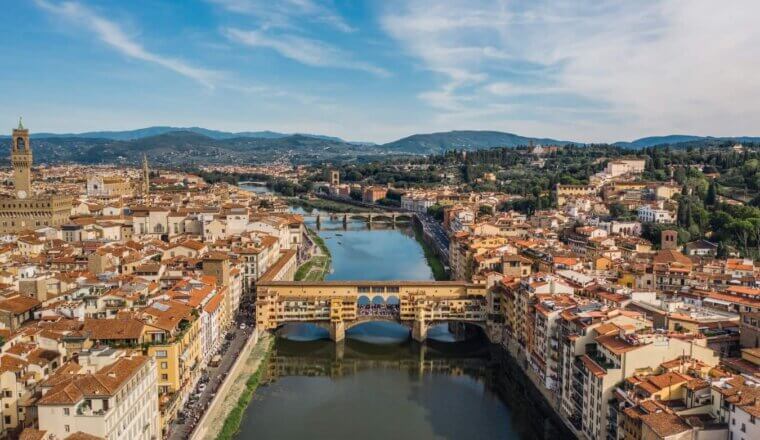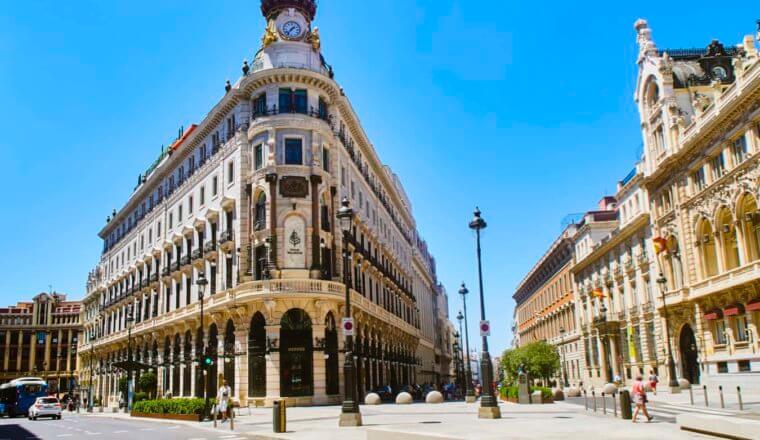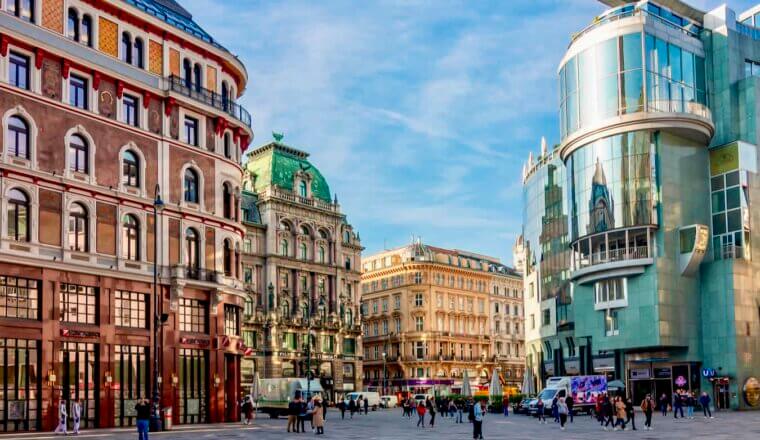Budapest, known for its fascinating history and its rocking nightlife, is a popular budget-friendly backpacker destination located on a beautiful stretch of the Danube River in Hungary.
This vibrant capital is home to spacious parks, grand historic buildings, bustling food halls, hip underground bars, and centuries-old thermal baths.
The city is popular with budget backpackers as well as with European vacationers and river cruisers looking to explore beyond the confines of Western Europe.
Beneath Budapest’s somewhat drab exterior and you’ll find a hip, cool city packed with affordable accommodation and cheap eats that fit quite nicely into even the tightest of budgets.
Budapest has everything you’ll find in Western Europe but for a fraction of the price (and with a fraction of the crowds too). Personally, I think it’s one of the most exciting cities in Europe!
This travel guide to Budapest can help you plan your trip, save money, and make the most of your time in this underrated city!
Table of Contents
Top 5 Things to See and Do in Budapest
1. Tour Parliament
Home to the National Assembly, this Gothic Revival building designed by Hungarian architect Imre Steindl is absolutely stunning. Opened in 1902, it’s right on the river and, to this day, remains the largest building in the country. Over 100,000 people worked on the construction of the building, and it took just under 20 years to complete. 40 million bricks, 500,000 precious stones, and 40 kilograms (88 pounds) of gold were used in its creation. Tours are available daily for 8,400 HUF.
2. Admire the National Gallery
Established in 1957, this art museum is located inside Buda Castle. Once one of the most glorious royal residences in Europe, Buda Castle dates to the 14th century and was restored in the Baroque style in the late 1700s. World War II damaged the palace severely and it was restored again in the 1960s before becoming home to the National Gallery in 1975. It has works from prominent Hungarian and European artists as well as a collection of Medieval altarpieces from the 15th century. During your visit, you can also check out the underground Habsburg Palatine Crypt and climb to the top of the iconic dome for panoramic views of the city. Admission is 3,400 HUF and an audio guide is 750 HUF.
3. Visit the baths
Budapest is famous for its thermal baths. The thermal waters from deep below the city have been an important part of Hungarian culture for thousands of years. Believed to possess a variety of health benefits, the waters are rich in zinc, calcium, and magnesium which can soothe muscle soreness, reduce inflammation, and improve skin. The oldest bathhouses in use date back to the 1600s. Széchenyi is the most famous, with indoor and outdoor pools, saunas, and dunk baths. It is one of the best experiences in Budapest and is the biggest medicinal bath in Europe. Other baths, such as Lukacs and Gellert are also worth a visit. Admission starts at 3,800 HUF.
4. Cruise the Danube
Many hostels organize weekly boat parties that cruise the Danube (the Budapest Party Hostel group is famous for theirs). Experience sweeping views of the city while dancing the night away. It’s the perfect way to combine partying with sightseeing and you can enjoy iconic landmarks lit up in all their nighttime glory. Other boat tours are available with or without dinner and drink options as well. Prices vary but expect to pay at least 7,000 HUF for a 4-hour trip.
5. Hit the Ruin bars
After World War II, many buildings in the city were left ruined and abandoned. Squatters, then artists, and now hipsters moved into them and have turned them into eclectic “ruin bars” that even the locals love. From the outside, the bars look like run-down buildings but step through the doors and you’ll find some of the most vibrant nightlife in Budapest. Ruin bars are filled with unique décor including eclectic antiques and graffiti art. Szimpla Kert was an old stove factory and has evolved into a venue that hosts live music and theater throughout the week. Fogasház is another of my favorites and has a massive dance floor and all-night parties.
Other Things to See and Do in Budapest
1. Take a free walking tour
If you want a complete overview of Budapest, take a free walking tour. It’s how I start all my trips to a new city. There are daily tours available from companies like Free Budapest Walking Tours, Strawberry Tours, Trip to Budapest, and Generation Tours. These tours are the best way to learn about the city’s history, culture, and architecture. Just remember to always tip your guide at the end!
2. Visit the House of Terror
This building is a museum and memorial to the thousands of people who were tortured and brutally killed under Hungary’s fascist and communist regimes. The exhibit takes you through the resettlement and deportation of thousands of Hungarians, including an interrogation chamber and displays of propaganda. There is also an exhibit on the Nazi and Soviet occupation of Hungary. From there, you can see reconstructed prison cells and information on the 1956 revolution. It’s not a light way to spend your afternoon but you’ll get massive insight into Hungary’s turbulent history. Admission is 4,000 HUF.
3. Go caving
Budapest has around 200 underground caves, all of which are on the Buda side of the city. Caving Under Budapest runs tours where you can climb up walls and squeeze through incredibly narrow spaces within the sprawling 30-kilometer (19-mile) cave system beneath the city. Tours start from 12,000 HUF.
4. Wander through the Great Market Hall
Built in 1897, this market is the largest (and one of the oldest) in Budapest. Heavily damaged during World War II, it remained that way until the 1990s when it was restored and re-opened in 1997. Don’t miss the Gothic Revival entrance and patterned tiled roof as you enter. Spanning 10,000 square meters (108,000 square feet), the market has vaulted glass and steel beam ceilings and three floors of stalls selling fresh fruits and vegetables, cheeses, sausages, spices, and local handicrafts. There is a food court inside the market on the second floor if you want to grab a bite and people-watch.
5. Visit the Royal Palace (Buda Castle)
Originally constructed in the 13th century, the huge Baroque complex you see today was built between 1749 and 1769. The palace’s days of being a luxurious living space ended in World War II when Nazi (and then Russian) troops looted it. Today, it’s home to a collection of museums, including the Hungarian National Gallery, Budapest History Museum, House of Houdini, Museum of Military History, Museum of Music History, Museum of Telephones, and the Golden Eagle Pharmacy Museum. Beneath the castle, there’s also a labyrinth that was used to imprison Vlad the Impaler!
6. Relax on Margaret Island
This popular island is smack in the middle of the Danube, connected by the Margaret and Árpád Bridges. It used to be a royal hunting reserve but has since been turned into a public park with lots to see and do. You can walk or drive golf carts (or scooters) around the island, explore the immaculate Japanese garden or the rose garden, chill on the beach, visit the small zoo, or visit the ruins of an ancient Franciscan Monastery. Margaret Island also has its very own thermal baths (Palatinus), complete with wave pools, swimming pools, and a water slide. Admission to the pools starts from 2,900 HUF. Exploring Margaret Island is free!
7. Take a day trip to Lake Balaton
For about 6,000 HUF, you can get a round-trip train ticket from the city to Lake Balaton. This is the largest lake in Central Europe (often called the “Hungarian Sea”) and a rich wine region that is also a hub for outdoor activities, especially cycling. There are also thermal baths here, with admission costing 3,800 HUF for three hours or 6,500 HUF for the day. You can also hike around the extinct volcanic landscape in the nearby Tapolca Basin, walk through lavender fields, and look for wildlife like deer and osprey in Balaton Uplands National Park.
8. Visit the Cave Church
This unique underground church is on the Buda side of the city. It was built in the 1920s in a cave that had been previously used by a hermit. The entire church was sealed up behind a wall of concrete until 1989 when the Berlin Wall came down and the church was reopened. There are lots of interesting relics, including a replica of the Black Madonna from Poland. Admission is 600 HUF which includes an audio guide.
9. See the Shoes on the Danube
Erected in 2005, this small monument is the creation of film director Can Togay and sculptor Gyula Pauer. During World War II, fascist militia rounded up 3,500 citizens (800 of which were Jewish) and ordered them to take off their shoes before they were executed and thrown in the Danube. This monument of bronze shoes represents the shoes taken off and left behind prior to the executions.
If you want to learn more about the history of Budapest’s Jewish population, take a self-guided audio tour around the Jewish Quarter. It takes just over an hour and includes 8 stops, including the stunning Dohány Street Synagogue.
10. Hike Gellért Hill
Named after Saint Gerard, this 235-meter (770-foot) hill overlooks the entire city. The climb up isn’t too taxing and the sweeping view over the entire city makes it worth the effort. At the peak, you’ll find a few vendors selling snacks and drinks. Look for the Szent Gellért Monument dedicated to Saint Gerard, who was the first Bishop of Csanád in what was the Kingdom of Hungary in 1030 CE. It’s popular to come here at sunset.
11. Visit the Budapest History Museum
This museum covers four floors of Buda Castle and offers a comprehensive overview of the city’s entire history. Some rooms date back to the 15th century, including the old cellar, which you’re free to explore. The museum also offers an insightful overview of the historical sites around the city center and their role in Hungarian history, from prehistoric times right up to the present. Admission varies by season (2,000-2,400 HUF).
12. See Matthias Church
Located near Castle Hill, the original church in this location was built in the 11th century. The current building was constructed in the 14th century over its ruins, seeing significant renovations in the 19th century. Some parts of the church still date back 500 years, however, including the carvings over the south entrance. The colorful roof of this church almost looks like it was built from Lego. Once inside, don’t miss the vaulted ceilings and ornate décor. In the Royal Oratory, you’ll find the Matthias Church Collection of Ecclesiastical Art, which has stunning artifacts like chalices and replicas of the Crown of St. Stephen. Admission is 1,800 HUF.
13. Admire St. Stephen’s Basilica
This is the largest church in Hungary. Its exterior is covered in ornate Neoclassical architecture propping up a tall dome. The inside is covered in gorgeous artwork and sparkling marble. Don’t miss all the little chapels inside, as well as St. Stephen’s mummified hand. Entry is 1,200 HUF, and it costs 2,200 HUF to visit the tower for views over the city. Remember to dress respectfully as it is a place of worship.
14. Hungarian Presidential Palace
This is the home of the Hungarian president. The palace is called Sándor-Palota (Alexander Palace), and while it’s not terribly eye-catching compared to the surrounding buildings, you can see the changing of the guard at the top of each hour for free (from 9am-5pm, excluding Sundays). Occasionally, the palace is open for tours in the summer (you’ll have to inquire in person about prices and hours as they occur infrequently).
15. See the Hungarian State Opera House
Designed by Miklós Ybl towards the end of the 19th century, this is the second-largest opera house in Budapest. It took almost 10 years to complete and is a Neo-Renaissance masterpiece that has welcomed world-class composers such as Gustav Mahler (he directed the opera from 1888-1891). Tours are 2,900 HUF and tickets for performances vary but expect to pay around 12,000 HUF.
16. Tour Heroes’ Square
Located at the end of Andrássy Avenue, Heroes Square is actually the largest square in the country. Its centerpiece is the Millennial Memorial featuring a 36-meter (118-foot) pillar topped with the Archangel Gabriel, surrounded by 14 statues of Hungarian kings (as well as other historical figures). The monument was built in 1896 to celebrate Hungary’s 1,000th anniversary. At this time, Hungary was part of the Austro-Hungarian Empire ruled by the Hapsburgs, and space was left for statues of future Hapsburgs leaders.
Budapest Travel Costs
Hostel prices – Budapest is famous for its hostel culture so you’ll find tons of budget-friendly options here. In peak season, dorm beds start at 3,000 HUF for an 8-10-bed dorm. Private rooms cost around 14,230 HUF per night, though they can be found for as little as 11,600 HUF if booked early. In the low season, you can find dorm rooms for as low as 2,100 HUF per night, while private rooms can be as low as 5,000 HUF.
Free Wi-Fi is standard and a couple of hostels also offer free breakfast. Most hostels have a kitchen if you want to cook your own meals.
For those traveling with a tent, camping is available outside the city. Expect to pay around 5,500 HUF for a basic plot for two people without electricity.
Budget hotel prices – Budget hotels with air conditioning, TV, and Wi-Fi can be found for as little as 11,000 HUF per night if booked early. But for most rooms, expect to pay at least 15,800 HUF per night.
Airbnb is also available in the city, with private rooms starting at 7,500 HUF per night (though they average closer to 17,000 HUF). For an entire home or apartment, prices begin around 15,000 HUF per night (though expect to pay at least 28,000 HUF unless you book early).
Food – Traditional Hungarian food is inexpensive and hearty. It’s very much a “meat and potatoes” country, with popular dishes being meat stew, smoked meats, casseroles, and dumplings. Túró is a popular local cheese and fruit pastries are a popular (and traditional) dessert. Be sure to try halászlé, a hot and spicy fish soup with paprika.
In Budapest, a meal at a restaurant serving traditional cuisine costs around 3,200 HUF. For a multi-course meal and a drink at a restaurant with table service, expect to pay closer to 7,000 HUF. For fast food (think McDonald’s), a combo meal costs around 2,200 HUF.
You can find pizza for around 2,100 HUF for a medium while Chinese food costs around 2,900 HUF. Thai food is around 3,000-4,000 HUF while pita or falafel costs 1,500-2,200 HUF.
Beer costs around 500-800 HUF while a latte/cappuccino is 700 HUF. Bottled water is 370 HUF.
If you plan on cooking your own meals, a week’s worth of groceries costs around 12,000-15,000 HUF. This gets you basic staples like rice, pasta, seasonal produce, and some meat. Lidl, Penny, and Aldi are the cheapest supermarkets to shop at if you’re on a budget.
For a variety of tasty eats, check out Street Food Karavan, a food truck lot with tons of delicious options. For hearty local eats, head to Hungarikum Bisztro. For vegan/vegetarian eats, check out Vegan Garden or Las Vegan’s. For dessert, La Donuteria has fancy vegan and non-vegan donuts.
Backpacking Budapest Suggested Budgets
On a backpacking budget of 11,500 HUF per day, you can stay in a hostel dorm, cook most of your meals and eat a little fast food, limit your drinking, use public transportation to get around, and do free activities like walking tours or exploring the market. If you plan on drinking, add another 600-1,200 HUF to your daily budget.
On a mid-range budget of 29,500 HUF per day, you can stay in a private hostel room or Airbnb, eat out at cheap restaurants serving traditional cuisine, have a few drinks, take the occasional taxi to get around, and do more paid activities like visiting museums and lounging in the thermal baths.
On a “luxury” budget of 48,000 HUF per day, you can stay in a hotel, eat out anywhere you want, drink as much as you want, rent a car for day trips, and do more guided tours and paid tours. This is just the ground floor for luxury though. The sky is the limit!
Budapest Travel Guide: Money-Saving Tips
Budapest isn’t an expensive place to visit. If you stick to local food markets, dorm rooms, and public transportation, it’s really hard to break the bank. Just limit your drinking. Sure, the beer is cheap but twenty of them add up!
Here are some other high-impact ways to save money in Budapest without sacrificing your trip:
- Take a free walking tour – There are plenty of free walking tours available, making for a great introduction to the city. This is the best (and cheapest!) way to explore while getting a detailed overview of the city and its culture and history. Just be sure to tip!
- Stay with a local – Couchsurfing allows you to stay on people’s couches or in their spare rooms for free. It’s a great way to save money while meeting locals who can share the ins and outs of their city.
- Cook your own meals – While eating out isn’t too expensive here, if you’re on a budget it’s cheaper if you cook your own meals. Head to a local grocery store and save your money!
- Get the Budapest Card – The Budapest Card is a travel pass that provides discounts and deals on attractions and activities in the city. You get free public transport, entry to the Lukács thermal baths, and admission to 17 museums. A 24-hour card costs 11,870 HUF, a 48-hour card costs 17,600 HUF, and a 72-hour card costs 23,000 HUF.
- Bring a water bottle – The tap water here is safe to drink so bring a reusable water bottle to save money and reduce your plastic use. LifeStraw is my go-to brand as their bottles have built in filters to ensure your water is always clean and safe.
Where to Stay in Budapest
Budapest has lots of great hostels and budget hotels. Here are some of my favorite budget-friendly places to stay:
How to Get Around Budapest
Public transportation – Budapest has an expansive network of buses that connect the whole city. Additionally, Budapest has a large network of streetcars/trams as well as trolleybuses with over a dozen routes. The city has a modern metro system too.
Tickets are valid on the bus, metro, trams, and trolleybuses, and can be purchased at any metro station with a single ride costing 350 HUF. If you want to avoid standing in the queues at the stations, you can also buy tickets at most newsstands, street stands, and ticket vending machines.
One standard ticket is good for one trip. That means if you need to transfer, you need a new ticket (unless you bought a transfer ticket).
You need to validate tickets before riding. If you are caught using public transport without a validated ticket you are liable for an on-the-spot fine.
If you know you are going to be using public transport while in Budapest then it may be worth purchasing a 24-hour transit pass for 1,650 HUF. You can also get a 72-hour card for around 4,150 HUF.
If you have a Budapest Card, public transportation is free.
Train – There are three main railway stations in Budapest that connect the capital with other cities in Hungary as well as to other neighboring countries. The 2.5-hour ride to Vienna can be done for as little as 3,680 HUF while the 2.5-hour trip to Bratislava costs around 4,500 HUF. The trip to Pecs also takes around 2.5 hours and costs around 4,500 HUF.
Ferry – There are two forms of public water transport in Budapest: the Danube River Ferry Service and the Riverboats (which only operate from May-September). The Danube River Ferry Service runs between Újpest and Millenniumi Városközpont while the Riverboats operate the services between Boráros tér and Pünkösdfürdo. The Riverboats depart every 90 minutes between 8am and 8pm with ticket prices ranging from 250-1,000 HUF
Taxi – Taxis start at 1,000 HUF and go up by around 400 HUF per kilometer. Avoid the taxis if you can as they can add up quickly and you can easily walk or take public transportation everywhere. There are no ridesharing services here like Uber.
Bicycle – Budapest is very bike-friendly and has over 200 kilometers (124 miles) of bike lanes. You can find rentals for around 1,200 HUF for 1 hour or 5,500 HUF for 24 hours.
Car rental – Car rentals can be found for as little as 6,500 HUF per day for a multi-day rental. Unless you’re planning some day trips, however, you won’t need a vehicle. If you’re driving, make sure to bring an International Driving Permit (IDP) — you’ll need one for any car rental.
For the best car rental prices, use Discover Cars.
When to Go to Budapest
Peak season in Budapest is June-August, when temperatures rise to 27-30°C (82-86°F). Budapest experiences a huge influx of visitors during this time and prices increase as well.
However, while the summer is the most popular time to visit, I think the best time to visit Budapest is the shoulder season in the spring and fall (April-May and September-October). It’s still warm, with temperatures hovering between 12-16°C (54-62°F), and there aren’t as many crowds. Prices are cheaper too.
Winter is from November to March. During this time, there is a lot of rain and snow, with many tourist attractions shutting down. Temperatures regularly drop below freezing. That said, November-December is fantastic for the Christmas markets. If you want to see the holiday markets and visit the museums then winter is a fun time to visit. Just dress warmly!
How to Stay Safe in Budapest
Budapest is a pretty safe city and violent crime is rare. However, scams and pick-pocketing can occur, especially around high-traffic areas and on crowded public transportation. Always keep your valuables secure and out of reach just to be safe.
One scam to be mindful of is the “large bar and restaurant bill” scam. It’s mostly solo male travelers who are the target of this scam. The scam starts when you are approached by a group of women who ask for a light or directions. They then ask if you want to come for a drink in a nearby bar. When the bill comes, it is very expensive and they will be unable to pay their share. This is a very common scam as the women are working for the bar. If you aren’t sure if it is a scam or not, try suggesting you all go to a different bar than the one they suggest.
Additionally, avoid this by checking the prices before ordering.
You can read about other common travel scams to avoid here if you’re concerned.
Solo female travelers should generally feel safe here, however, the standard precautions apply (never leave your drink unattended at the bar, never walk home alone intoxicated, etc.).
If you experience an emergency, dial 112 for assistance.
The most important piece of advice I can offer is to purchase good travel insurance. Travel insurance will protect you against illness, injury, theft, and cancellations. It’s comprehensive protection in case anything goes wrong. I never go on a trip without it as I’ve had to use it many times in the past.
Budapest Travel Guide: The Best Booking Resources
These are my favorite companies to use when I travel. They consistently have the best deals, offer world-class customer service and great value, and overall, are better than their competitors. They are the companies I use the most and are always the starting point in my search for travel deals.
- Skyscanner – Skyscanner is my favorite flight search engine. They search small websites and budget airlines that larger search sites tend to miss. They are hands down the number one place to start.
- Hostelworld – This is the best hostel accommodation site out there with the largest inventory, best search interface, and widest availability.
- Booking.com – The best all around booking site that constantly provides the cheapest and lowest rates. They have the widest selection of budget accommodation. In all my tests, they’ve always had the cheapest rates out of all the booking websites.
- HostelPass – This new card gives you up to 20% off hostels throughout Europe. It’s a great way to save money. They’re constantly adding new hostels too. I’ve always wanted something like this and glad it finallt exists.
- Get Your Guide – Get Your Guide is a huge online marketplace for tours and excursions. They have tons of tour options available in cities all around the world, including everything from cooking classes, walking tours, street art lessons, and more!
- The Man in Seat 61 – This website is the ultimate guide to train travel anywhere in the world. They have the most comprehensive information on routes, times, prices, and train conditions. If you are planning a long train journey or some epic train trip, consult this site.
- Trainline – When you’re ready to book your train tickets, use this site. It streamlines the process of booking trains around Europe.
- Rome2Rio – This website allows you to see how to get from point A to point B the best and cheapest way possible. It will give you all the bus, train, plane, or boat routes that can get you there as well as how much they cost.
- FlixBus – Flixbus has routes between 20 European countries with prices starting as low 5 EUR! Their buses include WiFi, electrical outlets, a free checked bag.
- SafetyWing – Safety Wing offers convenient and affordable plans tailored to digital nomads and long-term travelers. They have cheap monthly plans, great customer service, and an easy-to-use claims process that makes it perfect for those on the road.
- LifeStraw – My go-to company for reusable water bottles with built-in filters so you can ensure your drinking water is always clean and safe.
- Unbound Merino – They make lightweight, durable, easy-to-clean travel clothing.
- Top Travel Credit Cards – Points are the best way to cut down travel expenses. Here’s my favorite point earning credit cards so you can get free travel!
- BlaBlaCar – BlaBlaCar is a ridesharing website that lets you share rides with vetted local drivers by pitching in for gas. You simply request a seat, they approve, and off you go! It’s a cheaper and more interesting way to travel than by bus or train!
Budapest Travel Guide: Related Articles
Want more info? Check out all the articles I’ve written on backpacking/traveling Europe and continue planning your trip:
